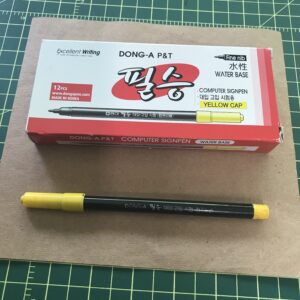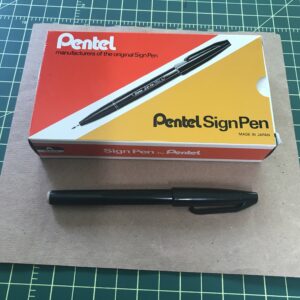I was drawing this morning with one of my favorite pens. It’s a simple black marker that I use all the time. It’s a Pentel Sign Pen. With all the art markers in my collection of art supplies the humble Sign Pen gets used quite a bit. It’s got a bit of an origin story with me too.
First of all the Sign Pen has been around for ages. There are other brands of them besides Pentel but it was the Pentel one that was around all the time during my childhood in the 1970s. It was the black marker that could be found in various stores that had school supplies. It was always among the pencils, paper, and ballpoint pens. I probably had them during my childhood but they made no special impression on me then.
It wasn’t until the late 1990s that I started using Sign Pens regularly for drawing. I was working in the Marvel Comics Bullpen in the late 1990s and for some reason I needed a black marker. I went into my boss Dan’s office and asked if there were any in the supply closet. There was so he gave me one and it was a Pentel Sign Pen. I did whatever task had to be done with it and really liked it.
After that I discovered I liked drawing with Sign Pens. The pens usually have dark black ink (there are color ones too) and a nib that’s hard with little give to it. The hard nib gives a consistent line weight to a drawing. It’s a fairly thick line too. Maybe a sixteenth of an inch across. I found it was good for making simple and small drawings. I liked it for getting down ideas in thumbnail sketches.
After using the pen I checked back with Dan to see if there were any more of the Sign Pens. There were. He told me that he ordered them for Michael Golden who was Marvel’s Art Director at the time. I found that interesting and popped into Michael’s office to ask him about the pens. He told me that he liked them too and learned about them during his time in the animation business. Because of the smooth single weight black line a lot of animators liked to use they to draw. Consistent line weight is an asset in the animation world.
After working with the Sign Pen for a little while I realized I had actually read about other comic book artists using them before. Most comic book artists used brushes, dip pens, and India ink to make cartoons but I remember reading about both Neal Adams and Gil Kane using Sign Pens to ink with at times back in the 1970s and 1980s.
One of the problems with Sign Pens back in those days was that the ink was fugitive. Unlike India ink or most of today’s magic markers back in the 1970s markers were made with an ink that would fade away after a few years. I’ve heard stories of Gil Kane inking comics with a Sign Pen in the early 1980s. Those pages faded to a light brown by the early 1990s. I even got to see a few of those faded pages at comic book conventions in the early 1990s.
I don’t remember seeing any Neal Adams finished art inked with a Sign Pen but I have seen various sketches and preliminary art that looks like it was done with one. It has a line that’s very recognizable to me these days.
The ink in Sign Pens these days is much better than it was in the 1970s. I have sketch books with Sign Pen ink in them that have been around for over 20 years and the ink hasn’t faded at all. In the early 1990s magic marker companies started making black markers aimed at artists and so they improved the ink in them. “Fade Proof” markers came into existence so much so that it trickled down to even the cheaper old markers. Now most black markers are “Permanent.”
I don’t always stick with the marker ink that comes in the Sign Pens. I discovered long ago that you can refill most black markers with India ink. The ink reservoir in markers is usually a sponge. So I get pliers and pull off the plug that’s on the back of a Sign Pen and pull out the tubular sponge that’s inside. Then I drip about 20-30 drops of ink onto the sponge. After that I put the sponge back in and replace the end plug the marker keeps going.
Though I’ve used many inks in markers I find that Technical pen ink works the best. Technical pen ink has glycerin in it. That’s a surface tension breaker that helps the ink flow. I find other inks work well for a while but then they clog up the sponge or something. It takes weeks to happen but eventually the ink stops flowing regularly. This doesn’t happen with technical pen India ink.
The year 2000 was the first time I filled up one of my 5.5×8.5 inch sketchbooks with drawings made with a Sign Pen. I call them my Inkbooks. I draw anywhere from six to nine small boxes on a page and fill up all the boxes with spontaneous ink drawings mostly done with a Sign Pen. I’ve filled up a book a year since then so I’m on Inkbook 23 right now. I pull one off the shelf and look through it when I need an idea for a drawing.
I found a website, years ago, called JetPens.com that has a lot of pens. I’ve bought and tried out a few different brands of Sign Pens from there. There is one Japanese brand of Sign Pens that have a yellow cap and are called “Computer Pens” (for some reason) that are good ones. Those and the Pentel ones have been the mainstays of my Inkbooks for decades.
Not all artists art like this but I love to try out new art supplies. It’s one of the ways I keep going. I love looking through art supply websites and catalogues and ordering all sorts of stuff but sometimes it’s the simple things that really work. The ordinary Sign Pen has been extraordinary for me.
As an addendum to this piece I’ve been reading a book called “Popism” by Andy Warhol. In it he mentions that in the early 1960s some of the people who worked in his studio, The Factory, used to take speed and then obsessively draw complex designs with Sign Pens. That is now the earliest mention of a Sign Pen that I’ve read.

